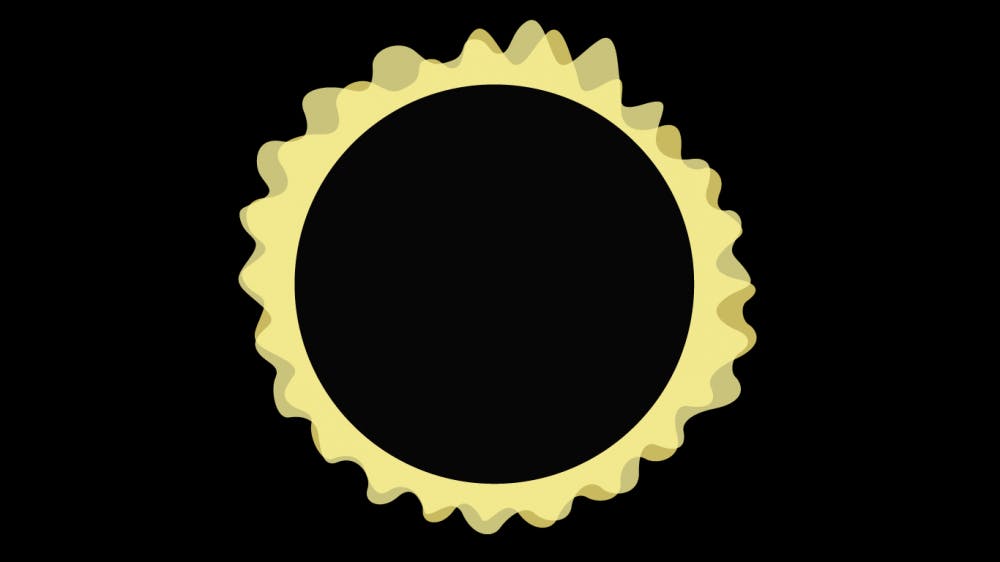A starry sky, twilight and a partly covered sun will greet students walking to their classes at 2:25 p.m. the first day of the fall semester, Aug. 21, as the first total solar eclipse in the United States since 1979 occurs over their heads.
The path of totality, the area where people can see the moon's shadow completely blocking the sun, is only 70 miles wide and will stretch from Oregon to South Carolina. As viewed from IU, close to 94 percent of the sun will be obscured from sight as the eclipse reaches its peak.
For those wanting to know more behind the science of the eclipse, hear a Pink Floyd cover band or score some free Moon Pies, the Office of Science Outreach and the Council for Arts and Humanities collaborated to organize CelestFest, a solar eclipse watch party at the Conrad Prebys Amphitheater from 1 p.m. to 4 p.m., accompanied by a concert that night from 7 p.m. to 9 p.m.
“CelestFest is our way of celebrating the natural phenomenon of the solar eclipse,” said Teddie Phillipson, the associate director of the Office of Science Outreach. “First day of classes, we’re going to see a natural phenomenon and just get to know each other. There’s a lot of time for networking and to build those relationships right before the academic year.”
The eclipse will be the first coast-to-coast total solar eclipse since 1918. The last time this happened, it happened over a world that hadn’t yet invented handheld hair dryers, movies with sound or penicillin.
“This is, while not quite exactly a once-in-a-lifetime experience, it’s a very rare occurrence and I’d like people to really learn from it,” IU Physics Club faculty adviser Fred Luehring said.
Viewing the eclipse directly is dangerous, as the sun’s rays are so concentrated that they can concentrate in the back of the eye and damage the retina without proper protection. Straight lines turning wavy and spotty or blurred vision are signs of eclipse-induced damage, but may manifest hours or days later after exposure, the Office of Science Outreach said on its website.
To ensure safety for those viewing the eclipse, IU will distribute 10,000 pairs of solar eclipse viewing glasses at First Year Experience Guide Tables and at the Conrad Prebys Amphitheater on a first-come, first-serve basis. Other ways to view the eclipse safely at home, like pinhole projectors, can be made with materials like aluminum foil and a cardboard box.
“Please, please, please, don’t look at the goddamn sun,” Luehring said.
CelestFest will feature eclipse-related demonstrations from multiple academic departments like Biology, Physics and Public Heath, eclipse-inspired celestial poetry activities and more. In the nine months of planning, the 12-person core committee worked to create the event’s interdisciplinary nature.
“To communicate better what all of us do, including science, we need arts and humanities. There’s nothing like art to communicate good science,” Phillipson said.
Phillipson said she expects 300 people attending the event, watching demonstrations or networking with professors and peers. She said one of her goals for CelestFest is to build connections between new people on campus and a sense of community overall.
“I’m sure we’ll have a lot of freshmen and sophomores who haven’t declared a major yet, and they might interact with history and philosophy or with someone in the sciences and say, ‘Oh, I never knew science was like that, I always thought it was very rigid and full of terms,’” Phillipson said.
A complete view of the eclipse is possible from Hopkinsville, Kentucky, 167 miles southwest, where the University’s astronomy department will go to view totality. In place of the astronomy department, Luehring and the physics club are stepping in to provide science content for CelestFest.
He said that he hopes the event will bring a better understanding of science to people.
“Understanding the solar system and the fact that the solar system is not the center of the universe is one of the greatest human intellectual accomplishments,” Luehring said. “If you stop and think about it, it’s really amazing that some people were able to calculate to the second when the eclipse will occur.”
For Phillipson, she said she hopes CelestFest will help decrease a recent backlash against science and intellectualism, reaching out to those with the misconception that science is rigid and inaccessible instead of tentative and ever-changing.
“There are people on campus who might feel that science isn’t for them because maybe they got a bad grade once in high school or maybe they didn’t get a blue ribbon in a science fair or something,” she said. “To bring them back around to view a natural phenomenon that can be explained by science or by other disciplines, they might be able to find themselves and feel more apt to instead of saying ‘science isn’t for me,’ realize that science is for everyone.”






